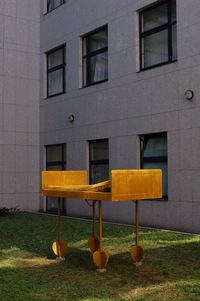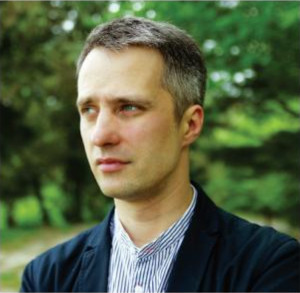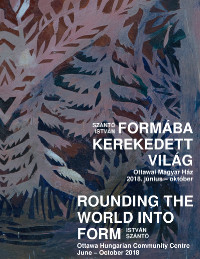Rounding the World into Form
Date/Time
Friday, June 1, 2018 - Saturday, October 20, 2018 / 18:00 - 20:30
Add to iCal calendar / Add to Google calendar
Exhibition of fine arts by István Szántó, Hungary
June – October, 2018
Related Posts
The Works of István Szántó
Folklore Remix
“We can observe symmetry, regularities and patterns everywhere in our daily life, on materials and clothing, on carpets and wallpapers, on walls and pavements. The transition from the practical arrangement to decorative-ornamental one is continuous. The decorative order is rarely completely pointless. Originally, it probably always had both practical and symbolic roles. Apparently, one of its most important tasks is “infinite muster /rapport/”
writes Hannes Böhringer, in his study on ornamentation, while he analyzes ornamentation in relation to order and disorder, simplicity and complexity.
The work of István Szántó is determined by this “endless muster”, i.e. the presence of ornamentation by almost endless repetition. And, of course, the motives that create this endless muster are not incidental, nor are the objects that have a role in his work.
Szántó is occupied with the rich storehouse of votive objects, the fact that people have created a variety of artefacts in this spirit over the years.
“I was fascinated by the offering of votive objects based on magical process, in which the object ensures the mystical power transfer between the sacred and the distressed person.” (István Szántó)
It is a great challenge for a contemporary creator how these things that are connected mostly to older eras and other cultures can be evoked in contemporary visualization. In addition, Szántó placed these objects mostly in a personal context. The best example is his Wax Bed, which is almost entirely the product of his subjective art, inspired by an illness in his family, yet it can be “read” easily without knowing the personal motivation of the artist. The bed legs that were exhibited in the atrium of the Heart Medical Clinic of Pécs ended in hearts, subtly referring to both the disease and the emotions. In a tragedy, pledges are particularly common and Szántó was basically interested in such things, so the bed itself has become such a votive object, which he donated the hospital in exchange for the cure.
He either paints these votive objects or creates an object, sometimes using the en-caustics rarely applied these days, while his gingerbread works and his series of specially inwrought paintings are even more special.
The gingerbread evokes old folk culture and motifs, on the one hand, and the food as the medium of work of art characterizes the eat art movement, one the other hand. This movement is followed by several people currently, in Hungary e.g.: Eszter Ágnes Szabó and Andrea Dudás Fajgerné. The eat art events are usually ad hoc actions, however, Szántó uses them permanently as mediums of his works, so new issues arise, for example, in relation to the durability of such works.
The cut out and pierced works belong to the characteristically unique works of Szántó. The simultaneously positive and negative line of inwrought forms, where the absence is a creative element as well. In such works, also symmetry and stylization have dominant roles. The cut and fade technique becomes an issue of content, since suggestion and secrecy play especially important roles in these works. The shadow appearing behind the hole created by the cut is an integral part of the painting. It is not purely an aesthetic accompanying element, but as the embodiment of the little or not seen background information and experiences or rather of the background world, lurking behind the things we do not see.
In his works, István Szántó brings back old techniques and motifs, and remixes these elements in a way to create contemporary pseudo folk art.
Translation and excerpt from:
Andrea Bordács, Szántó István folklórremixe, MŰBÍRÁLAT – TÁRLAT, Volume LX, No. 22, June 3, 2016)
Preface to “Rounding the World into Form” by Árpád Szabados Árpád (in Hungarian).
Sneak peak of the works.
Beeswax Bed
– votivus –

Beeswax Bed
votivus
I think of my work as a votive object in which scientific, psychic and spiritual thinking are all represented.
The hospital bed refers to medicine. Through the bed as object I wish to refer to scientific thinking with its exactitude and clearly defined outlines which, through incessant effort can grasp the world of phenomena and can heal efficiently. However, the cosmic point of view of cognition that is beyond the domain of our senses is overshadowed by scientific work. This pole is represented by wax – one of the materials of ethereal force in the works of Joseph Beuys, the most influential German artist of the post-WWII era.
To me, the hospital bed covered in wax represents lifegiving force, recovery and healing. Beeswax has a healing, transcendental power. This property is represented in folk religion in votive objects. Votive objects are characterised by an offering based on a magical process in which the object ensures the mystical transfer of power between the saint and the person in need.
I offer my work as a votive object intended to aid the successful healing of a beloved one.
István Szántó
About the Artist

István Szántó
István Szántó was born at Szombathely, Hungary, in 1978. This spring he obtained hit doctorate degree at the Faculty of Music and Visual Arts of University of Pécs (PTE), Hungary.
Contact: istvanszanto@hotmail.com
Most recent exhibitions
- Rounding the World into Form, Szombathelyi Képtár, 2016
- Ornamentics, Nádor Galéria Art and Med Kulturális Központ, Pécs, 2015
- Votivus, Pince Galéria, Agora, Szombathely, 2013
Most recent group exhibitions:
- Can Murals be Modern?, MODEM, Debrecen, 2017
- MANK Gallery, Szentendre, 2016
- Natural Arts – Variations, Műcsarnok, Budapest, 2016
- Constellation 77.78, Festőterem, Sopron, 2016
- 5. Textile Arts Triennial, Szombathelyi Képtár, 2015
- From Intimacy to the Public Sector, Művészetmalom, Szentendre, 2015
- Nyugat-magyarországi Egyetem Művészeti Intézet oktatóinak csoportos kiállítása, Zero Galéria, Savaria Egyetemi Központ, Szombathely, 2014
- Intertwined / Összefonódás, Zsolnay Kulturális Negyed, m21 Galéria, Pécs, 2014
- (Silence) – A Holocaust Exhibition, Ludwig Múzeum – Kortárs Művészeti Múzeum Művészetek Palotája, Budapest, 2014
- Votiv, re:public Galéria, PTE-BTK Kommunikáció- és Médiatudományi Tanszék, Pécs, 2014
- Doctor of Liberal Arts (DLA) Intro – PTE Művészeti Kar Doktori Iskola hallgatóinak kiállítása, re:public Galéria, PTE-BTK Kommunikáció- és Médiatudományi Tanszék, Pécs, 2013
- Doctor of Liberal Arts (DLA) Exhibition, Nádor Galéria, Pécs, 2013
- Eau de Couleurs, Várfok Galéria, Budapest, 2013
- Doctor of Liberal Arts (DLA) Exhibition from the Archives of the Faculty of Music and Fine Arts of University of Pécs, Zsolnay Kulturális Negyed, m21 Galéria, Pécs, 2013
On the Menu
 Cooked Debreceni Sausage with Bread and Mustard |
|
 Coffee and Tea |
 Soft drinks, beer, wine and liquors available at the bar. |
We can only guarantee the seating for reservations received in time, and dining is by reservations only. Please make yours by 9 PM on Friday prior to the event. Reservations successfully submitted through the web are confirmed by e-mail.
Bookings
Bookings are closed for this event.

